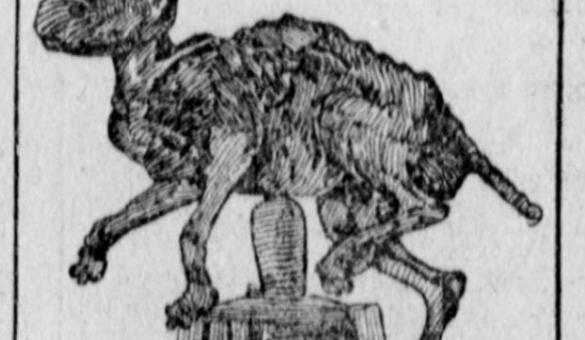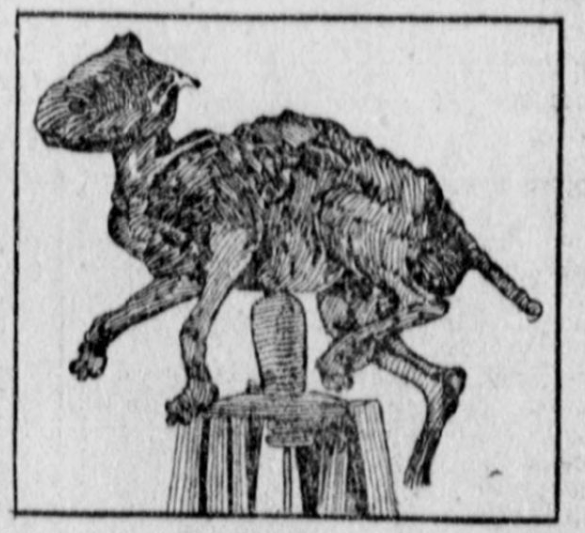
Mummified cats have been found in the walls of buildings, inside of ships, and in curiosity shops around the world. People were once fascinated by mummified cats and would even varnish “homemade” mummified cats to make them appear ancient.
Here are several accounts about mummified cats that I found in the newspaper archives.
1. Auctioned off
Auctioning off mummified cats for something other than fertilizer became rather popular after this auction stunt in 1890:

“Mark Twain once asserted that on the railway to Cairo mummies were used for fuel, and that an engineer had been heard to say to his fireman: ‘These durned plebeians don’t burn worth a cent; pass out a king.’ This flight of imagination has almost been equaled by actual fact, for recently a Liverpool merchant created some excitement and a great deal of amusement by offering for sale at auction an assorted cargo of 180,000 mummified cats… The sale called out a large attendance.
“One specimen, of which the auctioneer declared that its head was a perfect study for a sweet face, realized 3 shillings, 3 pence. Of another, it was asserted that, though not handsome, it was better than beautiful; it was good. This animal went for 4 shillings 6 pence…” [Source]
2. Look in the attic
What happened to all of these mummified cats sold in the auctions?
From 1943, Berkeley, California:

“Searching through the attic of a house into which they had just moved, Mr. and Mrs. Vernon Bullock found an old box, put together with screws. It appeared it might hold a treasure. The lid was unscrewed – and there lay a mummified cat.
“In the box also was a letter, dated Liverpool, England, March 24, 1897, to which was attached a certificate of a registered postal packet. It explained the item was “sacred and of no small value.” [Source]
3. Stuffed with newspaper
We find that these ancient Egyptian mummified cats were so popular that merchants would often sell fakes.
From 1907, we find the following account:
“A dealer in antiquities sold to one of the subjects of Kaiser Wilhelm an Egyptian mummified cat, which was found to be stuffed with copies of a modern London newspaper. This is a relic which would have probably pleased the innocent who traveled abroad under the personal supervision of Mark Twain.” [Source]

4. Found in wall
There were also numerous mummified cats being found in walls.
“A mummified cat was found when workmen altering the front of the Episcopal diocesan house tore out the stonework at the top of the second story. The house was built in 1828, so the cat had been there 83 years, at least.” [Source]
5. He varnished his pussy
One guy, after finding a mummified cat in 1918, varnished the remains to make it look like an ancient Egyptian relic:
“A few weeks ago, Mr. A.C. Heron found a mummified cat under an old house he was moving from… The mummy is well preserved and Mr. Heron has it varnished to look like a genuine imitation.” [Source]
6. She displayed her dead cat
In this next report from 1906, we find a woman who took an active part in mummifying her cat.
‘Mrs. McClure, proprietor of the Commercial Hotel, is the possessor of the body of a mummified cat. It is a souvenir of the period a year ago when homes were being fumigated.
“The Commercial Hotel was one of the places fumigated, and in one of the rooms of the place the pet cat of the proprietor was later found dead. It was found that the hair was falling from the body of the cat and the flesh seemed to be hardening, so the owner decided to place the body in some place and allow it to remain and await developments. The body was suspended where it could not be reached, and has now become a perfect mummy, similar to those exhumed from the tombs of ancient Egypt.” [Source]

7. Ship’s cat
And finally, mummified cats were also found in war ships, such as in this 1903 account:
“When the British war ship Menelaus was broken up the workmen were amazed to find in the side of the vessel a mummified cat. The war ship was built at Plymouth in 1808, and it is supposed that while she was being built the unlucky feline, pursuing a rat, jumped between the lining and the outside planking and was wedged there. This unique specimen of mummification is now in the hands of the British customs authorities, but will probably pass into the custody of some museum.” [Source]

